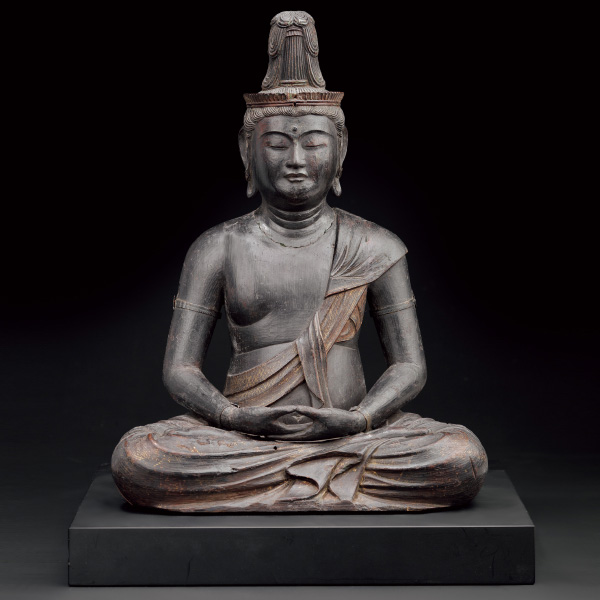
・作者:行順
・年代:鎌倉時代(文永七年・1270年)
・法量:像高 30.9cm
Seated Statue of Dainichi Nyorai
Artist: Gyōjun
Era: Kamakura period (Bunei 7, 1270)
Dimensions: Height of the statue 30.9 cm
法界定印(坐禅の印)を結ぶ胎蔵界大日如来の坐像。大日如来には胎蔵界大日如来と、忍者のような智拳印を結ぶ金剛界大日如来の二種がありますが、うち胎蔵界像は比較的遺例が少なく、貴重な作例です。
本像の構造は、頭体幹部(頭と体の主要部分)をヒノキの一材で彫出し、耳の後ろを通る線で前後に割り、内部を刳り抜く一木割矧造で、瞳には水晶製の玉眼を嵌入しています。本像は像内墨書から、文永七年(1270)、静快を大願主として、佛師行順が制作した仏像であることが分かります。鎌倉時代に遡る仏像で、制作年代と作者、制作事情が判明する仏像は稀で、このような仏像は墨書を持たない多くの仏像の年代を考える上での参考となるため、基準作と呼ばれます。本像は小像ですが、13世紀後半の仏像を研究する際の基準作として、学術的に貴重な仏像です。
A seated statue of Dainichi Nyorai in the Taizokai (Womb Realm) mudra (meditation mudra). There are two types of Dainichi Nyorai: the Taizokai Dainichi Nyorai and the Kongokai Dainichi Nyorai, who forms the Chiken-in mudra like a ninja. The Taizokai statue is relatively rare and a valuable example.
The structure of this statue involves carving the head and main body from a single piece of cypress wood, splitting it front and back along a line passing behind the ears, and hollowing out the interior, known as the ichiboku-zukuri technique. The eyes are inlaid with crystal. From the inscription inside the statue, it is known that this Buddha statue was made in 1270 by the Buddhist sculptor Gyōjun, with Jōkai as the main patron. It is rare to find a Buddha statue from the Kamakura period with known production date, artist, and circumstances. Such statues are called standard works because they help determine the age of many other statues without inscriptions. Although small, this statue is academically valuable as a reference work for studying Buddha statues from the late 13th century.
